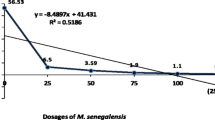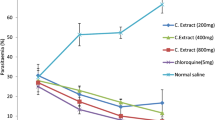Abstract
In the previous work, methanol extracts of Carpesium rosulatum (Compositae) were found to have high antiplasmodial activity against Plasmodium falciparum in vitro, this activity being largely attributable to a ineupatorolides A (I-A). In the present study, encouragingly, I-A was also found to have potential antimalarial activity in vivo when tested against Plasmodium berghei in mice. I-A (2, 5, 10 mg kg−1 day−1) exhibited a significant blood schizontocidal activity in 4-day early infection, repository evaluation, and in established infection with a significant mean survival time comparable to that of the standard drug, chloroquine (5 mg kg−1 day−1). The I-A possesses a promising antiplasmodial activity, which can be exploited in malaria therapy.


Similar content being viewed by others
References
Biorjman A (1991) Malaria. Waiting for the vaccine. GAT target. Wiley, Chichester
Clarkson C, Maharaj VJ, Crouch NR (2004) In vitro antiplasmodial activity of medicinal plants native to or naturalised in South Africa. J Ethnopharmacol 92:177–191
Etkin NL (1997) Antimalarial plants used by Hausa in northern Nigeria. Trop Doct 27:12–16
Kirby GC, O’Neil MJ, Philipson JD, Warhurst DC (1989) In vitro studies on the mode of action of quassinoids with activity against chloroquine-resistant Plasmodium falciparum. Biochem Pharmacol 38:4367–4374
Knight DJ, Peters W (1980) The antimalarial activity of N-benzyloxydihydrotriazines. I. The activity of clociguanil (BRL 50216) against rodent malaria, and studies on its mode of action. Ann Trop Med Parasitol 74:393–404
Lorke D (1983) A new approach to practical acute toxicity testing. Arch Toxicol 54:275–287
Moon HI (2007) Antiplasmodial activity of ineupatorolides A from Carpesium rosulatum. Parasitol Res 100:1147–1149
Peters W (1965) Drug resistance in Plasmodium berghei Vincke and Lips, 1948. I. Chloroquine resistance. Exp Parasitol 17:80–89
Ryley JF, Peters W (1970) The antimalarial activity of some quinolone esters. Ann Trop Med Parasitol 84:209–222
Trager W, Jensen JB (1976) Human malaria parasites in continuous culture. Science 193:673–675
Author information
Authors and Affiliations
Corresponding author
Rights and permissions
About this article
Cite this article
Chung, IM., Kim, MY. & Moon, HI. Antiplasmodial activity of sesquiterpene lactone from Carpesium rosulatum in mice. Parasitol Res 103, 341–344 (2008). https://doi.org/10.1007/s00436-008-0977-5
Received:
Accepted:
Published:
Issue Date:
DOI: https://doi.org/10.1007/s00436-008-0977-5




